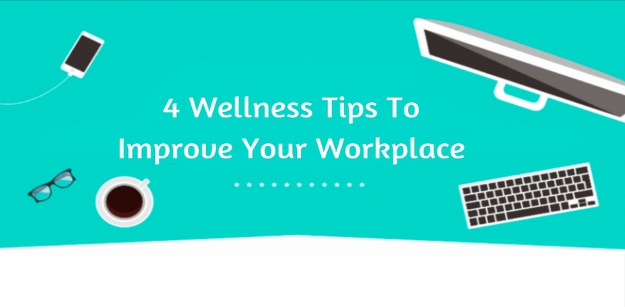Many businesses actively advertise for creative, hardworking candidates. Not only are these traits good for business, they can also be personally fulfilling for the employees that display them. Too often however, business owners don’t provide the conditions to let their staff flourish. Creativity is suppressed, and personal well being is sidelined with every pressing deadline.

Affording time for wellness in the workplace is always a hard sell, as it’s hard to prove outright that it will make you more successful. But not every change needs to be momentous, and even the smallest details can reap exponential benefits. Here then are four wellness tips that should help to improve your workplace.
1. Brighten up your workspace
It may seem like a cheap gimmick, but a brighter and more colourful workplace really is a happier one. You don’t have to go full Google with bean bags and pool tables, but seriously consider your decor. If your workplace has a policy against personal clutter, for instance, or people seem reluctant to bring it in, try and ease off a bit. Photographs and decorative objects bring the benefits of a home office to work, without the drawback of extra distractions.
Think too about your colour scheme and office layout. Believe it or not, preliminary research does seem to indicate that certain colours can provoke certain emotions. Try to go for bright, warm colours that aren’t too distracting or glaring under heavy office lights. As for the layout, recent research indicates that an open plan office is simply too noisy and distracting to be functional. Try instead to combine the traditional with the modern, and offer airy meeting spaces alongside more private workstations.
2. Assess your management style
However much you consider yourself as ‘just another employee’, being a manager or business owner is tough. It’s a fine line between giving staff the freedom and comfort to work effectively, and cracking the whip if things need to tighten up. You should always be open and willing to assess this balance, and consider whether you could do more to ease the mental burden that some employees might experience.
Look out for any instances of discrimination in your workforce, and ensure that there are clear and unbiased channels to forward complaints to the top. Consider too your working practices, and whether any part of your day-to-day operations inconveniences or is otherwise difficult for employees. Ensuring that your workplace is accessible and welcoming to every worker ensures a diverse staff, and a diverse array of ideas.
3. Offer your support
Mental health is an increasingly heavy burden on society, with almost 15% of people being affected in the workplace. Stress from work can also combine with other problems to exacerbate mental health issues, and decrease people’s ability to work and live freely. With a persistent stigma over mental health, and worries that speaking out could affect a person’s career, it’s key that you demonstrate deference and understanding when dealing with mental health issues in the workplace.
While mental health problems can be persistent and often unpredictable, prevention is always better than a cure. Work from home days, generous leave and lengthy lunch breaks can provide healthy breaks to the working week, allowing for respite from stressful conditions. Consider also investing in stress busting solutions like a games room, yoga sessions, or meditation. Yoga has been proven to moderate our response to stress, while meditation and mindfulness are recommended by NICE as treatments for depression.
4. Be open to ideas
Happy and engaged employees produce creative ideas, but they also need a place to voice them. If your business’ chain of command is too complex, or managers are too standoffish, then staff will be put off, potentially making them feel despondent and not valued. The same principle that there’s no such thing as a stupid question also applies to ideas.
They may not end up being suitable, but there’s nothing lost by providing a place to voice them. On the contrary, you and your employees are only likely to learn, and this will improve your process going forwards. Ensure that this openness is expressed at every level of your organisation, and if possible, provide a channel for ideas to flow from the bottom to the very top. Staff will feel more valued, and your business could become more reactive as a result.